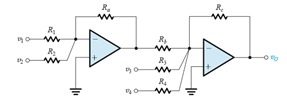This set of Electronic Devices and Circuits Multiple Choice Questions & Answers (MCQs) focuses on “The Inverting Configuration”.
1. When does a resistance provide a negative feedback to an amplifier?
a) Resistance is connected between the positive input terminal and the output terminal
b) Resistance is connected between the negative input terminal and the output terminal
c) Resistance is connected between the input terminals
d) Resistance is connected between the negative input terminal and ground
View Answer
Explanation: An op amp is said to have a negative feedback when a resistance is connected between the input and output terminals respectively.
2. The effect of the inverting configuration is
a) The output signal and the input signal are out of phase by 180o
b) The output signal and the input signal are in phase
c) The output phase is leading the input phase by 90o
d) The output phase is lagging behind the input phase by 90o
View Answer
Explanation: Inverting introduces a phase shift of 180o or it ‘inverts’ a peak.
3. For an ideal negative feedback configuration which of the following is true?
a) There is a virtual open circuit between the input terminals
b) The closed loop gain for a negative feedback does not depend only on the external parameters
c) There is a virtual short circuit between the input terminals
d) There is a virtual ground at the negative input terminal
View Answer
Explanation: There is always a virtual short circuit in this type of case. There will be a virtual ground if and only if one of the terminals is grounded.
4. The negative feedback causes
a) The voltage between the two input terminals to the very small, ideally zero
b) The voltage between the two input resistance very high, ideally infinite
c) Current flow through the positive input terminal and no current flows through the negative input terminal
d) Both a and c
View Answer
Explanation: Ideally the input terminals are at the same potential but in real practice there is a very small potential between the two terminals.
5. The non-inverting closed loop configuration features a high resistance. Therefore in many cases unity gain follower called buffer amplifier is often used to
a) Connect a high resistance source to high resistance load
b) Connect low resistance source to low resistance load
c) Connect low resistance source to a high resistance source
d) Connect high resistance source to a low resistance load
View Answer
Explanation: Buffer amplifiers are required to connect a high resistance load to a low input resistance output.
6. The advantage of a weighted summer operational amplifier is
a) It is capable of summing various input voltages together
b) Each input signal may be independently adjusted by adjusting the corresponding input resistance
c) If one needs both sign of a voltage signal then two operational amplifiers are needed
d) All of the mentioned
View Answer
Explanation: All of the mentioned are characteristics of a weighted summer operational amplifier over the traditional amplifier.
7. The following is a circuit of weighted summer capable of summing coefficients of both sign. The expressions for the output voltage v0 is

a) v0 = v1 (R1/Ra ) (Rc/Rb ) + v1 (Ra/R2 ) (Rc/Rb ) – v1 (Rc/R3 ) – v1 (Rc/R4 )
b) v0 = – v1 (R1/Ra ) (Rc/Rb ) – v1 (Ra/R2 ) (Rc/Rb ) + v1 (Rc/R3 ) + v1 (Rc/R4 )
c) v0 = v1 (Ra/R1 ) (Rc/Rb ) + v1 (Ra/R2 ) (Rc/Rb ) – v1 (Rc/R3 ) – v1 (Rc/R4 )
d) v0 = – v1 (Ra/R1 ) (Rc/Rb ) – v1 (Ra/R2 ) (Rc/Rb ) + v1 (Rc/R3 ) + v1 (Rc/R4 )
View Answer
Explanation: The voltages are increased first by the left side of the portion and then are also magnified by the right side of the circuit. There are four inputs given out of which two are magnified twice and the other are magnified only once.
8. You are provided with an ideal op amp and three 10kΩ resistors. Using series and parallel resistor combinations, how many different inverting-amplifier circuit topologies are possible?
a) 2
b) 3
c) 4
d) 5
View Answer
Explanation: Consider series and parallel combination of the resistances provided and arrange then in the feedback region and as output resistance.
9. The loop gain for an ideal operational amplifier with R1 = 10kΩ and R2(negative feedback) = 1MΩ is
a) 20 db
b) 40 db
c) 60 db
d) 80 db
View Answer
Explanation: Loop gain in this case is given by 20 log (1000000/10000).
10. In an inverting op-amp circuit for which the gain is −4 V/V and the total resistance used is 100 kΩ. Then the value of R1 and R2 (negative feedback)
a) R1 = 20KΩ and R1 = 80KΩ
b) R1 = 80KΩ and R1 = 20KΩ
c) R1 = 40KΩ and R1 = 60KΩ
d) R1 = 50KΩ and R1 = 50KΩ
View Answer
Explanation: Solve R1 + R2 = 100
R2/R1 = 4 for R1 and R2 respectively.
Sanfoundry Global Education & Learning Series – Electronic Devices and Circuits.
To practice all areas of Electronic Devices and Circuits, here is complete set of 1000+ Multiple Choice Questions and Answers.
If you find a mistake in question / option / answer, kindly take a screenshot and email to [email protected]
